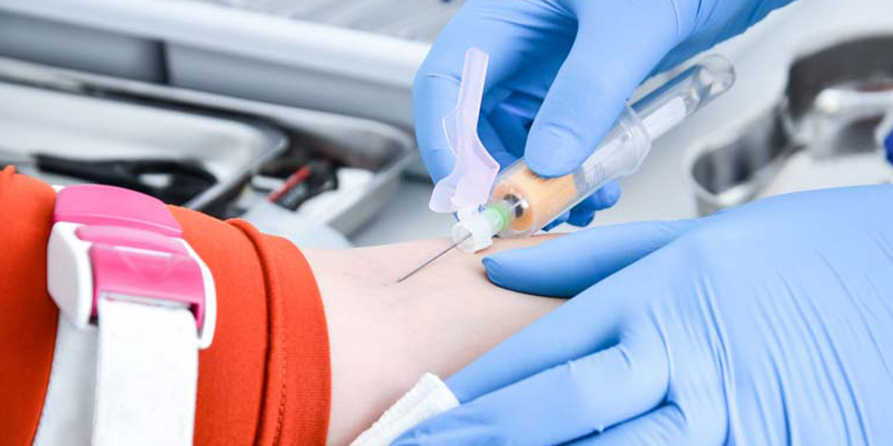Pharmacist Phlebotomy Training

Phlebotomy services offered from community pharmacy is becoming ever more popular due to the increasing demand for COVID tests. Below is some background information about what proprietors and managers need to know when considering starting a service.
What is pharmacy phlebotomy?
A healthcare professional trained in phlebotomy collects venous blood (via venipuncture - see image below) for testing by an offsite clinical laboratory. This is considered superior clinically from non-venous finger prick testing (such as Point of Care Tests (POCT)) as it allows for higher accuracy. Until relatively recently phlebotomy was only doctors and senior nurses, phlebotomy is now routinely carried out privately and via NHS commission by many pharmacies across the UK1.

Is there a demand for phlebotomy from pharmacy?
In a nutshell yes, there have been examples of community pharmacies being commissioned by local CCGs, most notably Coventry LPC won a small commissions. In addition, due to the COVID out break there is now a surge in demand for disease antibody testing.
Is it worth starting a phlebotomy service in your pharmacy?
This question is always relative dependent on the community you serve. If you have not already done so we highly recommend that you go through the following stages before you consider a phlebotomy service.
- Flu - now a nationally commissioned NHS service
- Occupational health - including hepatitis B, finger prick HBsAg tests.
- Travel clinics - including a yellow fever centre.
The reason why we suggest doing the above is the relative ease of adoption. For instance, the majority of pharmacists will be pre-trained for flu and existing stock ordering should be in place. Our flu PGD comes along with a Hepatitis B vaccine PGD which is an easy next step, where the pharmacist can also learn finger prick testing. Flu also contains a meningitis vaccine PGD which allows for immunisation of pilgrims going on Hajj or Umrah, which is another short step from a travel clinic service.
What are the risks of starting a phlebotomy service in your pharmacy?
As mentioned above it is our belief that all new services should be gradually adopted as they potentially pose a risk to both the employer and health worker3. It is still common to see a phlebotomist carry out dangerous practices known to increase the risk of needle-stick injury and transmission of disease. Dangerous practices include:
- recapping used needles using two hands;
- recapping and disassembling vacuum-containing tubes and holders;
- reusing tourniquets and vacuum-tube holders that may be contaminated with bacteria and sometimes blood;
- working alone with confused or disoriented patients who may move unexpectedly, contributing to needle-sticks.
As we have over a decade of experience with phlebotomy we have curated our courses to minimise risk. Our content includes:
Four types of practical sampling skills:
- Arterial sampling
- Capillary sampling
- Blood culture collection
- Venous blood draws
Online course content includes:
- The need for specialised training
- What does phlebotomy training involve?
- Workplace competency
- Choosing a training provider
- Keeping up to date
- Sources of further reading
- The anatomy and physiology of veins in the human arm and leg, and how to decide which one to use.
- Infection control.
- Which equipment and technique to use for which category of patient or purpose.
- How blood clotting works.
- Communication and patient preparation.
- Basic Life Skills and CPR
- Preparing the room and your workspace.
- Safe handling of ‘sharps’ (items that may cut or puncture your skin, such as needles).
- How to prevent needle stick injuries (when you accidentally scratch or puncture the skin on yourself of a patient).
- What to do if there is a needle stick injury.
- Contra-indications for venepuncture – which means when it would be unsafe to proceed, or when special measures are required to minimise risk.
- Any potential complications and what to do.
- Correct labelling and reporting requirements.
What sort of things can blood samples help with?
The most common tests include: full blood count, urea and electrolytes (known as ‘U&E’s), thyroid function tests etc. Each result is then analysed against the normal range. So, for example, if someone’s white blood count is high this can indicate the presence of an infection or something else. A wide range of medical conditions and illnesses can be diagnosed by investigating the chemical structure of blood samples. It's also a way of measuring and monitoring the progress of some health issues and managing certain medical conditions such as heart, liver or kidney disease or diabetes.
Why choose Voyager Medical and HubNet.io as your phlebotomy service partner?
- All of our trainers are pharmacists who have worked in community pharmacy and know what a busy dispensary looks like!
- We can provide a service platform for patient accessing the service (such as voyagerhealth.co.uk) and for data entry by the pharmacist (hubnet.io)
- We provide a wide range of dates and locations throughout the UK.
Reference:
1 PSNC Services Database - Phlebotomy Service. Accessed on 2 Jul 2020 via: https://psnc.org.uk/?our-services=phlebotomy-service
2 Coventry Pharmacy Phlebotomy service. Accessed on 2 Jul 2020 via: http://www.coventrylpc.co.uk/services/phlebotomy/
3 "WHO guidelines on drawing blood: best practices in phlebotomy". Accessed on 2 Jul 2020 via: http://www.euro.who.int/__data/assets/pdf_file/0005/268790/WHO-guidelines-on-drawing-blood-best-practices-in-phlebotomy-Eng.pdf?ua=1
Hubnet
Hubnet is an online pharmacy information system. We intend to provide healthcare professionals with an online ecosystem to allow for better communication between each other and their patients. Protected by law, the data you enter into this site remains your intellectual property and cannot be used by us. Our goal is to enable you to do more, if you like it you can subscribe for more!
Latest Tweets
